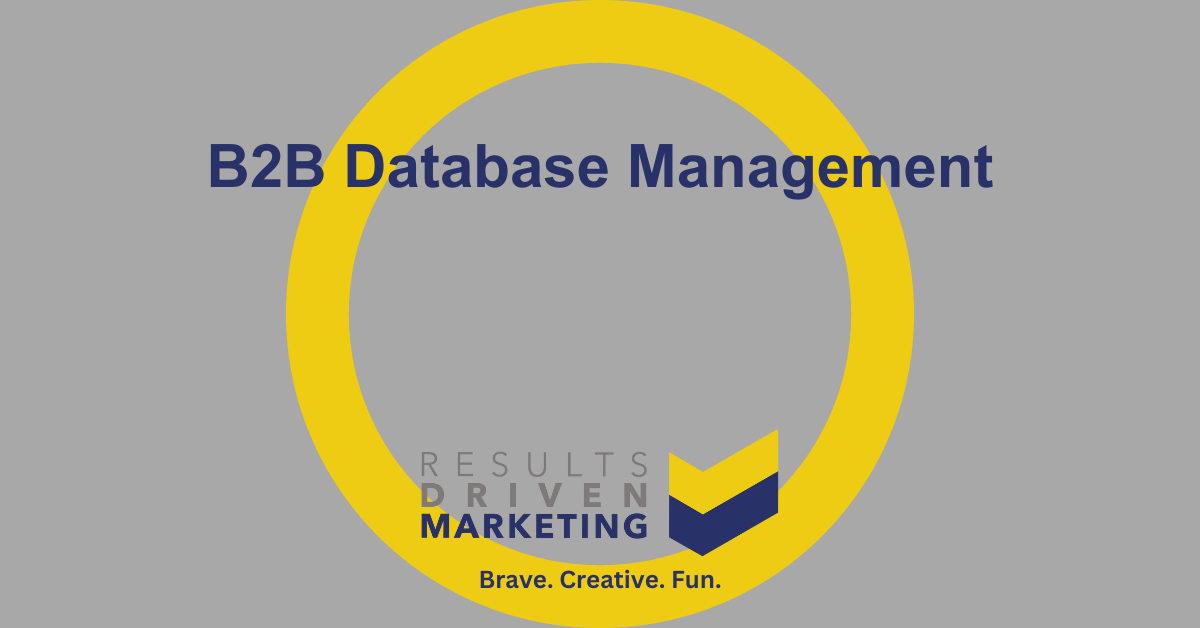
Implement These B2B Database Management Strategies Today
In the ever-evolving landscape of business, B2B database management often emerges as a daunting challenge many grapple with. Are you constantly wrestling with outdated contacts, fragmented data, or missed opportunities?
You’re not alone. Dive into this article as we unravel the intricacies of B2B database management, shedding light on common pain points and offering actionable insights to transform your data woes into strategic wins. Let’s embark on this journey to harness the true potential of your B2B database.
What is B2B Data Management?
B2B data management is, in essence, the art and science of handling and optimising business-to-business data. It’s not just about collecting data; it’s about making that data work for you. Think of it as the engine room of your business operations, ensuring everything runs smoothly and efficiently.
What is B2B data?
Now, you might be wondering, what exactly is B2B data? In simple terms, B2B data refers to any information that businesses exchange with each other. This could be anything from contact details of key decision-makers to transaction histories, product preferences, and more. It’s the lifeblood of data management in B2B marketing, providing invaluable insights and driving strategic decisions.
What does B2B data consist of?
B2B data is a vast ocean, teeming with various types of information. At its core, B2B data typically consists of:
- Firmographics: Details about companies, such as size, location, and industry.
- Transactional Data: Information about past transactions, purchases, and interactions.
- Behavioural Data: Insights into how businesses interact with your brand, be it through website visits, email engagements, or social media activity.
- Contact Data: Specific details about individuals within businesses, like job titles, email addresses, and phone numbers.
A definition of data management
So, we’ve talked a lot about data, but what about data management? At its heart, data management is the systematic process of collecting, storing, and using data efficiently and effectively. It’s not just about having a database; it’s about ensuring that database is a well-oiled machine, delivering the right insights at the right time. Database management meaning, in a nutshell, is making data accessible, reliable, and actionable.
Data quality — the obstacle to data-driven marketing (H2)
We’ve all heard the saying, “Garbage in, garbage out.” This couldn’t be truer when it comes to data management in B2B marketing. The quality of your data can make or break your marketing efforts. High-quality data can propel your campaigns to new heights, while poor data can send them crashing down.
What is bad data?
Bad data is essentially any data that is inaccurate, outdated, or irrelevant. It’s the kryptonite of effective database management. Examples of bad data include:
- Duplicate Entries: The same information entered multiple times.
- Outdated Information: Old email addresses or phone numbers that are no longer in use.
- Inaccurate Data: Incorrect details, be it a misspelled name or a wrong job title.
In the world of B2B, where decisions are often high-stakes and data-driven, the importance of avoiding bad data cannot be overstated. It’s crucial to regularly cleanse and update your database, ensuring you’re always working with the best possible information.
Components and Types of B2B Data Management
In the intricate tapestry of B2B operations, data management stands out as a pivotal thread. But, let’s be honest, it can sometimes feel like you’re trying to decipher a foreign language. So, let’s break it down, shall we? Dive in as we explore the various components and types that make up the world of b2b data management.
What are the Components of B2B Data Management?
B2B data management isn’t just a singular entity; it’s a multifaceted beast. To truly grasp its essence, we need to understand its various components:
- Data Architecture: Think of this as the blueprint of your data management system. It’s the structure that holds everything together, defining how data is collected, stored, and accessed.
- Data Modelling: This is where we give shape to our data. Data modelling involves creating abstract representations of the database structure, ensuring data is organized in a way that’s both efficient and effective.
- Data Administration: The unsung hero of b2b data management. It’s all about managing and overseeing the data lifecycle, ensuring everything runs like a well-oiled machine.
- Data Quality: As we’ve touched upon earlier, quality is paramount. This component focuses on ensuring the data is accurate, relevant, and up-to-date.
- Data Integration: In today’s interconnected world, data often comes from a myriad of sources. Data integration is all about bringing this data together, ensuring it’s cohesive and consistent.
- Data Analytics: Data on its own is just numbers and letters. Analytics is what brings it to life, extracting insights and driving informed decisions.
- Data Security: In an age of cyber threats, protecting your data is more important than ever. This component is all about safeguarding your data from potential threats.
- Data Governance: The rulebook of database management. It defines the policies, procedures, and standards that ensure data is managed in a consistent and compliant manner.
What are the seven types of B2B data?
Now, let’s delve a bit deeper into the types of B2B data. Each type serves a unique purpose, offering insights that cater to different facets of business operations:
- Demographic data: This is all about the who. It provides insights into the characteristics of businesses, such as size, industry, and location.
- Firmographic data: A step beyond demographics, firmographics delve into the structure and behavior of companies, offering a more detailed view.
- Technographic data: The tech landscape is ever-evolving. Technographics offer a snapshot of a company’s tech stack, from software and tools to platforms and systems.
- Chronographic data: Time is of the essence, and chronographics focus on the when. It provides insights into timelines, durations, and sequences.
- Intent data: Delving into the realm of the why. Intent data sheds light on a company’s intentions, be it purchasing decisions or future strategies.
- Quantitative data: The numbers game. Quantitative data is all about metrics, statistics, and measurable data.
- Qualitative data: Beyond the numbers, qualitative data offers insights into perceptions, opinions, and subjective data.
There you have it, a comprehensive look into the world of B2B data management. Whether you’re exploring database management examples or diving into database management principles, understanding these components and types is crucial. After all, knowledge is power, and in the world of B2B, data is king.
Benefits and Advantages of B2B Data Management
In the bustling world of business, data is often likened to gold. But why, you ask? Well, let’s dive deep and uncover the myriad benefits and advantages that b2b data management brings to the table.
What are the Benefits of B2B Data Management
B2B data management, when done right, can be a game-changer. It’s not just about collecting data; it’s about leveraging it to drive tangible results. Here’s a closer look at some of its standout benefits:
- Creating Ideal Customer Profile (ICP): Imagine having a crystal-clear picture of your ideal customer. With effective database management, you can craft an ICP that aligns perfectly with your business goals, ensuring your marketing efforts are always on point.
- Make Data-driven Business Decisions: Gone are the days of shooting in the dark. With robust data management in b2b, every decision you make is backed by solid data, reducing risks and amplifying outcomes.
- Increase Customer Engagement and Loyalty: By understanding your customers’ needs and preferences, you can tailor your offerings, leading to increased engagement and, in turn, loyalty.
- Enhanced Demand Gen and Lead Gen: With a well-managed database, targeting potential leads becomes a breeze. It’s all about reaching the right people at the right time, and b2b data management makes it possible.
What are the advantages of b2b data management?
In a nutshell, b2b data management streamlines operations, boosts efficiency, and drives growth. From optimising marketing campaigns to enhancing customer relationships, the advantages are manifold. It’s the secret sauce that gives businesses an edge in today’s competitive landscape.
Challenges and Disadvantages in B2B Data Management
But, as with all things, it’s not all sunshine and rainbows. While the benefits of data management in b2b marketing are undeniable, there are challenges and disadvantages that businesses need to be wary of.
Key Considerations for Data Management in B2B Business
Navigating the world of database management requires a keen understanding of its various facets. Here are some key considerations to keep in mind:
- Data Security: With cyber threats on the rise, ensuring your data is secure is paramount. It’s all about safeguarding your most valuable asset.
- Data Integration: As businesses grow, so does their data. Integrating data from various sources can be a daunting task, but it’s crucial for consistency and accuracy.
- Data Quality: As we’ve touched upon earlier, quality is key. Regularly cleansing and updating your database ensures you’re always working with accurate and relevant data.
- Data Governance: Setting clear policies and procedures ensures data is managed in a consistent and compliant manner.
- Data Analytics: It’s not just about collecting data; it’s about analysing it to extract actionable insights.
- Data Privacy: With regulations like GDPR in place, ensuring data privacy is more important than ever.
- Data Storage: As data volumes grow, so does the need for efficient storage solutions.
- Data Visualisation: Visual representations of data can offer invaluable insights, making complex data easily digestible.
- Data Backup and Recovery: In case of unforeseen events, having a robust backup and recovery system in place is crucial.
- Data Ethics: Ethical considerations in database management cannot be overlooked. It’s all about using data responsibly and ethically.
What are the disadvantages of b2b data management?
While the advantages of b2b data management are many, it’s essential to be aware of potential pitfalls. From the risk of data breaches to the challenges of keeping data up-to-date, businesses need to be proactive in addressing these challenges. Moreover, without the right tools and expertise, database management can become a resource-intensive task.
In conclusion, while b2b data management offers a plethora of benefits, it’s essential to approach it with a balanced perspective, understanding both its advantages and challenges.
Strategies and Best Practices
In the dynamic realm of B2B, data isn’t just numbers and letters; it’s the compass guiding businesses towards success. But, let’s face it, without the right strategies and best practices in place, even the most comprehensive database can fall short. So, let’s dive in and explore how businesses can truly harness the power of b2b data management.
Why Businesses must have a B2B Data Management Strategy?
In today’s cutthroat business landscape, having a data management strategy isn’t just a nice-to-have; it’s an absolute must. But why, you ask? Well, here’s the lowdown:
- Market Segmentation: One size doesn’t fit all, especially in the world of B2B. A robust data management strategy allows businesses to segment their market, tailoring their offerings to cater to specific niches and demographics.
- Making Data Accessible: Data that’s locked away in silos is of little use. A well-thought-out strategy ensures that data is accessible to all relevant stakeholders, from marketing teams to sales reps.
- Making Data Actionable: It’s not just about collecting data; it’s about turning it into actionable insights. With the right strategy in place, businesses can leverage their data to drive informed decisions and strategies.
Best Practices for Effective Customer Data Management in B2B eCommerce
In the bustling world of B2B eCommerce, customer data is the crown jewel. But, as with all treasures, it needs to be handled with care. Here are some best practices to ensure your customer data management is on point:
- Gather Customer Data Precisely: Precision is key. Ensure that you’re collecting accurate and relevant data, be it through forms, surveys, or interactions.
- Leverage Social Media: Social media isn’t just for selfies and memes. It’s a goldmine of customer data. By integrating social media insights into your database management, you can gain a deeper understanding of your customers’ needs and preferences.
- Set Security as Your Priority: In an age of data breaches and cyber threats, security cannot be overlooked. Ensure that your customer data is protected at all times, be it through encryption, firewalls, or secure access protocols.
- Perform Follow-up Calls or Feedback Forms: Feedback is a gift. Regularly touch base with your customers, be it through calls or feedback forms, to gather invaluable insights.
- Optimise Popup and Registration Forms: First impressions matter. Ensure that your popups and registration forms are optimised for user experience, making data collection seamless and efficient.
- Keep Reassessing Which Data Contributes to Business Outcomes: The world of B2B is ever-evolving. Regularly reassess your data to ensure it’s aligned with your business goals and outcomes.
In conclusion, while b2b data management offers a plethora of benefits, it’s essential to approach it with a strategic mindset. By implementing the right strategies and best practices, businesses can truly harness the power of their data, driving growth, innovation, and success.
What are the key considerations with regard to b2b data management?
When diving into the vast ocean of b2b data management, it’s essential to have a roadmap. After all, navigating these waters without a clear direction can be, well, a tad overwhelming. So, what should businesses keep in mind? Here’s a quick rundown:
- Data Accuracy: Ensure that the data you’re working with is accurate and up-to-date. Remember, even the smallest inaccuracies can lead to significant missteps.
- Integration Capabilities: In today’s interconnected world, data often comes from a myriad of sources. Ensuring seamless integration is crucial for consistency and efficiency.
- Scalability: As businesses grow, so does their data. Ensure that your data management system can scale with your business needs.
- Compliance: With regulations like GDPR in the mix, ensuring data compliance is more important than ever.
- User-Friendliness: A data management system that’s complex and hard to navigate can be a major roadblock. Opt for systems that are user-friendly and intuitive.
Alternatives to B2B Data Management
While b2b data management is undeniably powerful, it’s not the only game in town. Let’s explore some alternatives, shall we?
What are the alternatives to b2b data management?
- Manual Data Handling: Some businesses prefer the old-school approach, managing data manually through spreadsheets and documents. While it may lack the efficiency of modern systems, it offers simplicity.
- Third-party Data Providers: Instead of managing data in-house, businesses can opt to purchase data from third-party providers. It’s a quick fix but comes with its own set of challenges.
- Hybrid Systems: A mix of manual and automated systems, hybrid systems offer flexibility, allowing businesses to choose the best of both worlds.
FAQ
Navigating the world of B2B data can often lead to a barrage of questions. Let’s tackle some of the most common ones:
How do you get B2B data?
B2B data can be sourced through various channels, including trade shows, webinars, online forms, and third-party data providers.
Why should you use data for B2B sales?
Data offers invaluable insights, allowing businesses to tailor their sales strategies, identify potential leads, and drive informed decisions.
What is a B2B database?
A B2B database is a collection of business-to-business data, including details about companies, key decision-makers, and transaction histories.
How does the customer data management process work?
It involves collecting, storing, and analysing customer data to drive informed business decisions and strategies.
How to enhance, refresh and clean your B2B database?
Regularly update your database, remove outdated or inaccurate entries, and integrate new data sources to ensure it remains relevant and accurate.
What are the top B2B data trends in 2023?
With the rise of AI and machine learning, predictive analytics, real-time data processing, and data privacy are some of the top trends to watch out for.
How to Improve Data Management for B2B Marketing?
Invest in the right tools and platforms, prioritise data quality, integrate data sources, and regularly review and update your database management strategies.
In conclusion, while the world of b2b data management may seem complex, with the right approach and a clear understanding, businesses can truly harness its power. Whether you’re exploring database management examples or diving deep into database management principles, the key lies in staying informed and proactive.





